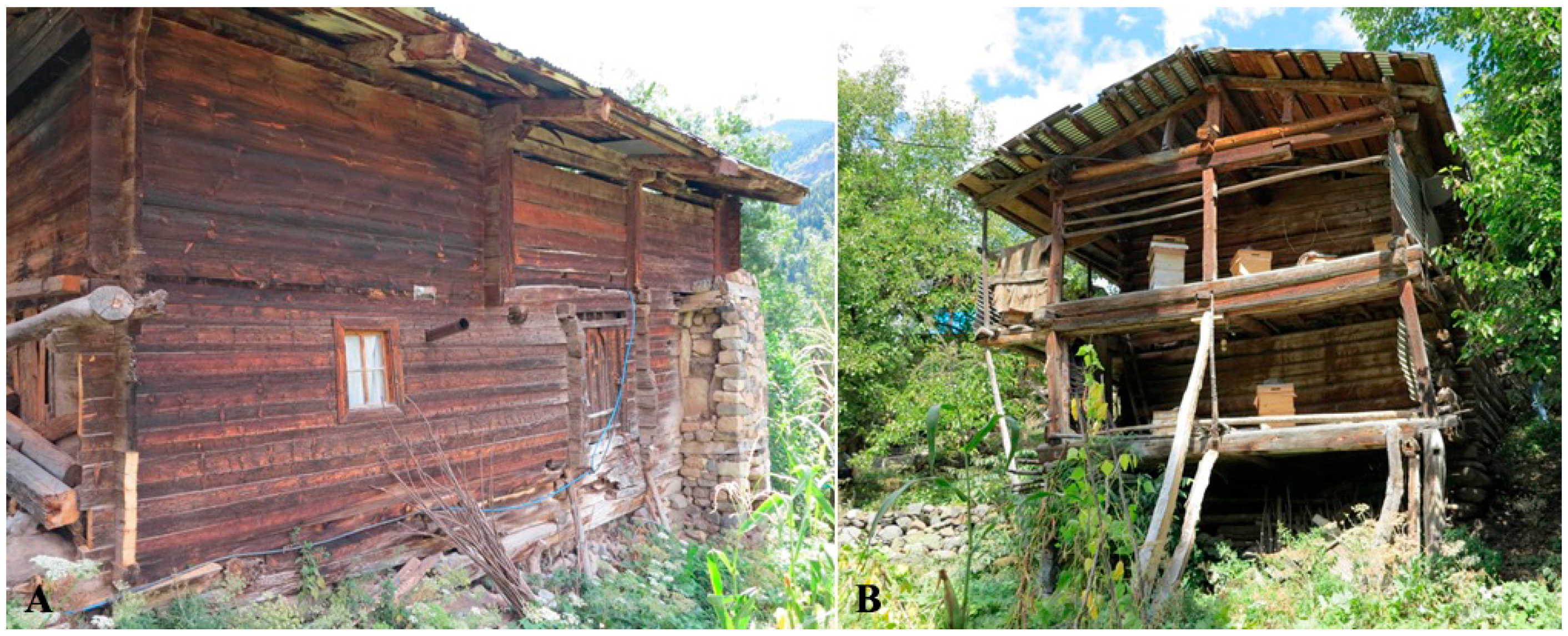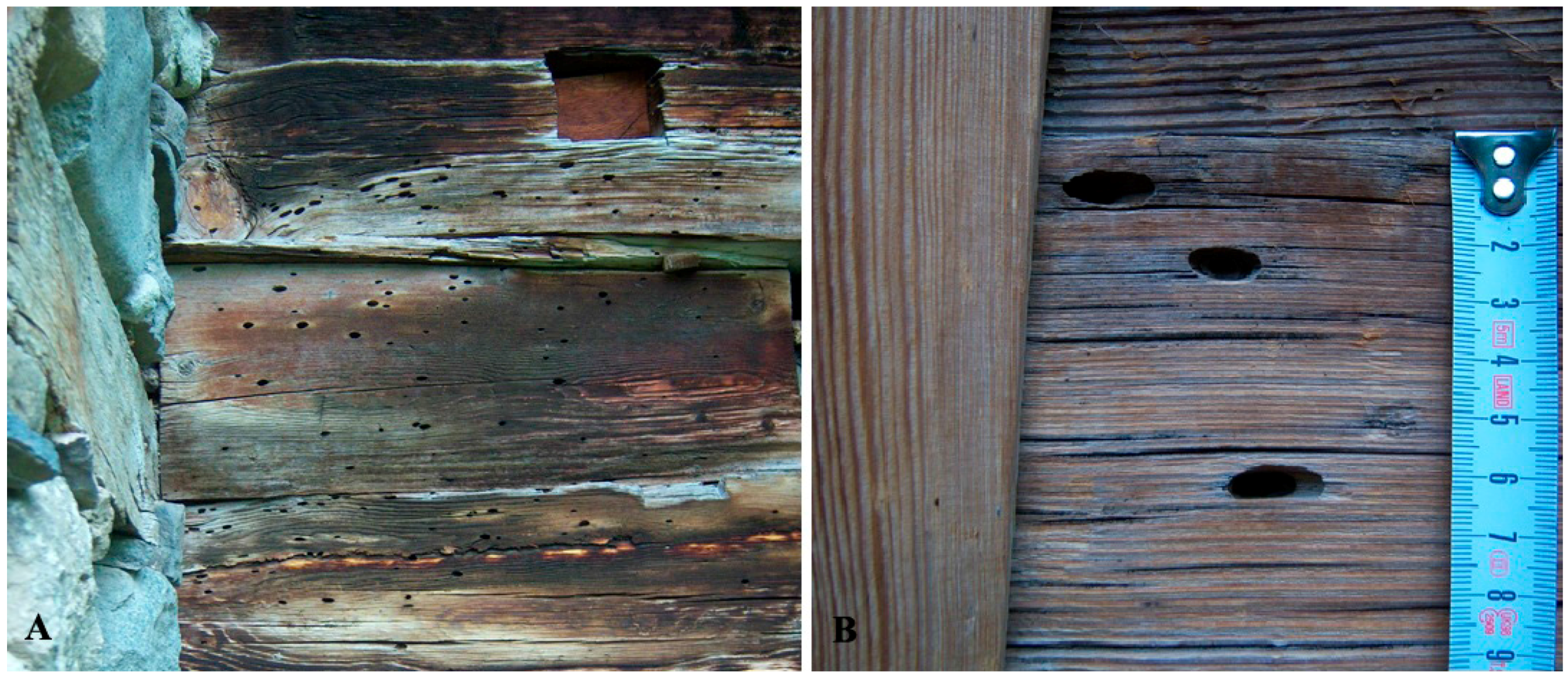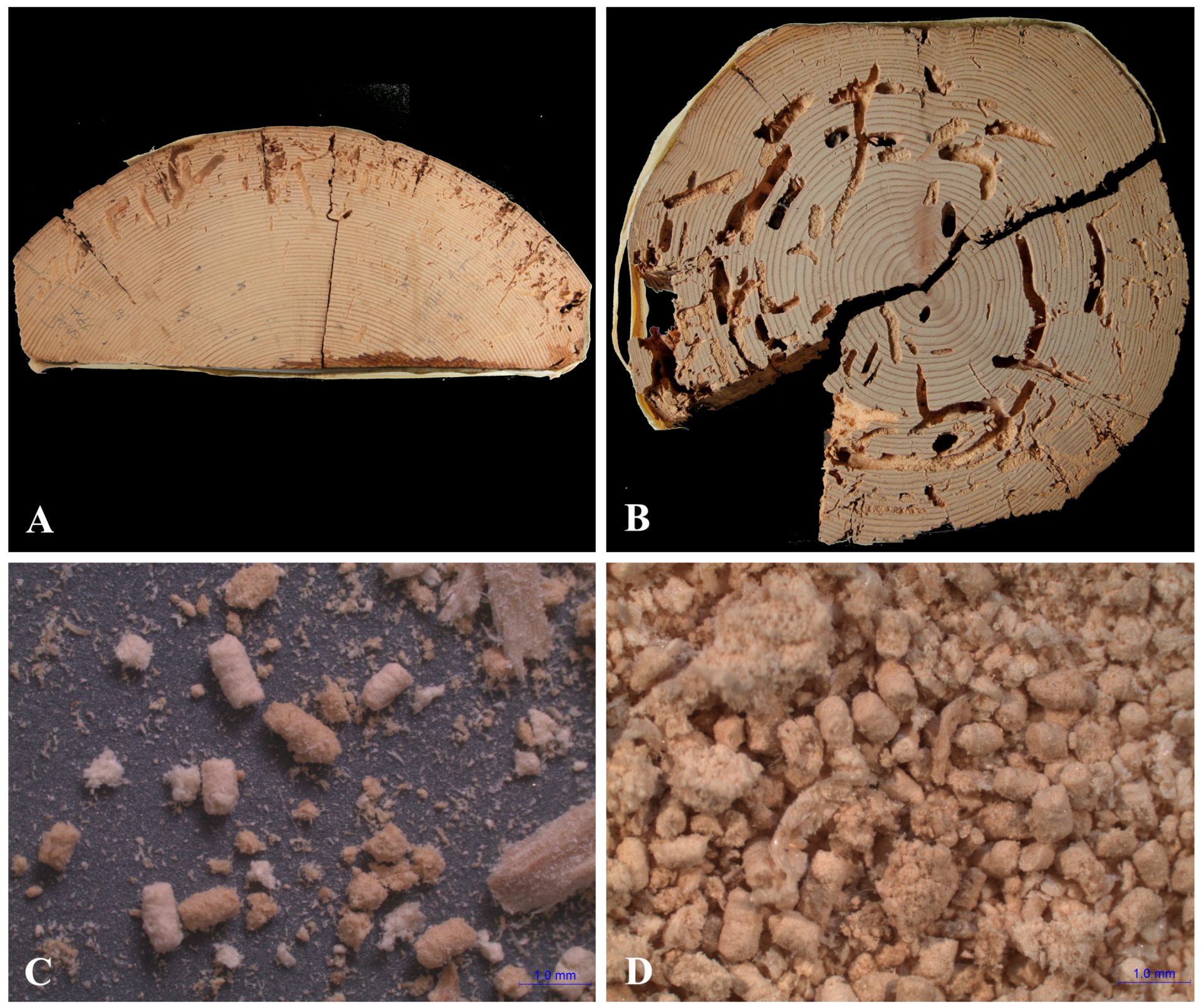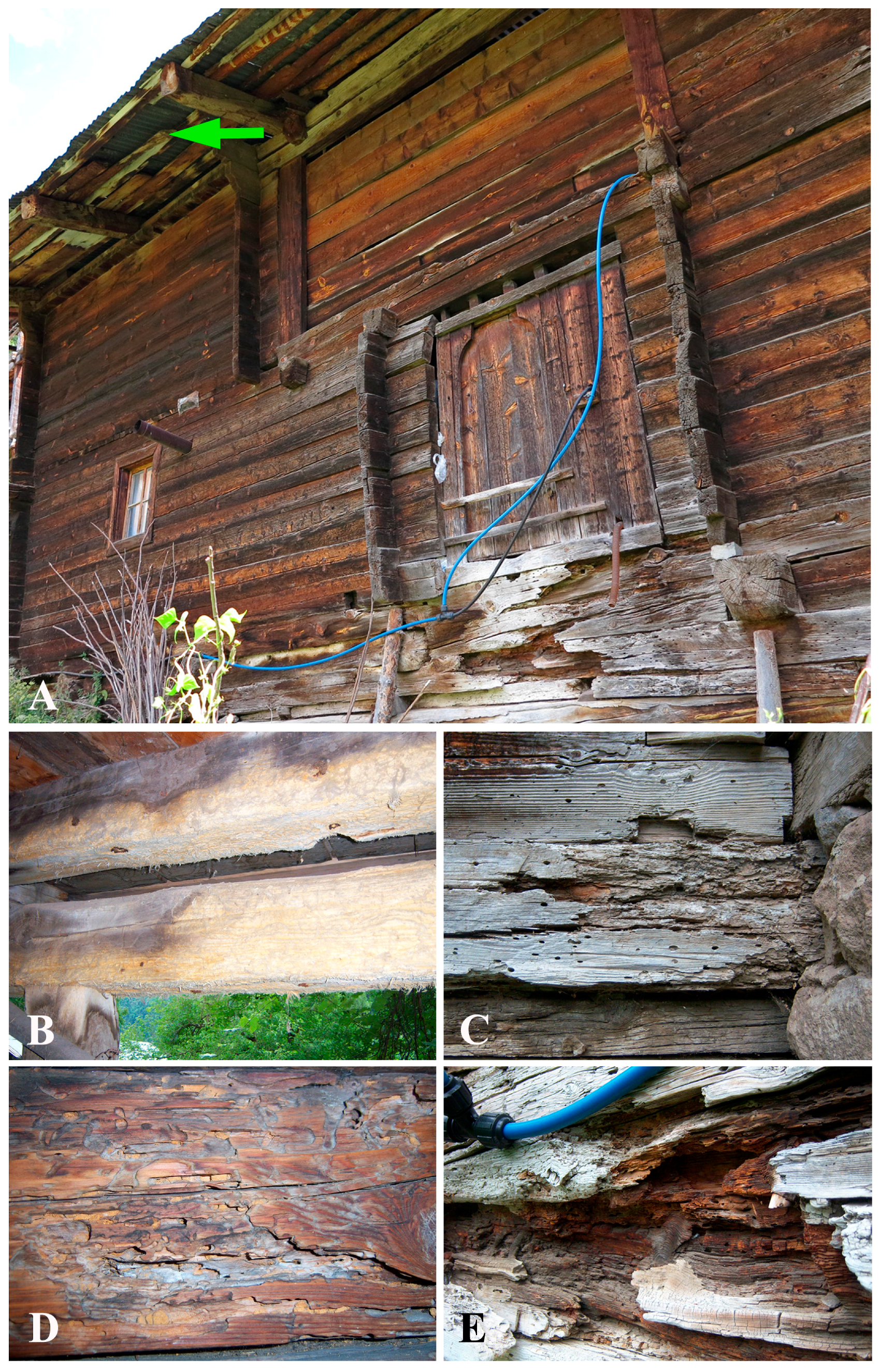Assessing Ecotourism Potential of Traditional Wooden Architecture in Rural Areas: The Case of Papart Valley
Abstract
:1. Introduction
2. Study Area
3. Materials and Methods
3.1. Determination of Ecotourism Resource Values
3.2. Application of SWOT Analysis
3.3. Investigation of Damage in Wooden Buildings
3.4. Dating of the Wooden House Using Dendrochroacheological Methods
4. Results
4.1. Ecotourism Resource Values of Papart Valley
4.2. The Results of a SWOT Analysis
4.3. Degradation Results
4.4. Dating of the Wooden House and the Hayloft
5. Discussion
6. Conclusions
Acknowledgments
Author Contributions
Conflicts of Interest
References
- Sharpley, R. Ecotourism: A Consumption Perspective. J. Ecotour. 2006, 5, 7–22. [Google Scholar] [CrossRef]
- Weaver, D.B.; Lawton, J.L. Twenty years on: The state of contemporary ecotourism research. Tour. Manag. 2007, 28, 1168–1179. [Google Scholar] [CrossRef]
- Perkins, H.; Debra, G.A. Ecotourism: Supply of nature or tourist demand? J. Ecotour. 2009, 8, 223–236. [Google Scholar] [CrossRef]
- Yeo, M.; Piper, L. The Ethics and Politics of Defining Ecotourism: Not Just an Academic Question. Int. J. Hum. Soc. Sci. 2011, 1, 11–18. [Google Scholar]
- Cobbinah, P.B. Contextualising the meaning of ecotourism. Tour. Manag. Perspect. 2015, 16, 179–189. [Google Scholar] [CrossRef]
- Blamey, R.K. Principles of Ecotourism, the Encyclopedia of Ecotourism; CABI Publishing: New York, NY, USA, 2001; pp. 5–22. [Google Scholar]
- Fennell, D. Ecotourism, 2nd ed.; Routledge: London, UK; New York, NY, USA, 2003. [Google Scholar]
- Honey, M. Ecotourism and Sustainable Development: Who Own Paradise, 2nd ed.; Island Press: Washington, DC, USA, 2008. [Google Scholar]
- Das, M.; Chatterjee, B. Ecotourism: A panacea or a predicament? Tour. Manag. Perspect. 2015, 14, 3–16. [Google Scholar] [CrossRef]
- Briedenhann, J.; Wickens, E. Tourism routes as a tool for the economic development of rural areas—Vibrant hope or impossible dream? Tour. Manag. 2004, 25, 71–79. [Google Scholar] [CrossRef]
- Frochot, I. A benefit segmentation of tourists in rural areas: A Scottish perspective. Tour. Manag. 2005, 26, 335–346. [Google Scholar] [CrossRef]
- Semple, W. Traditional architecture in Tibet: Linking issues of environmental and cultural sustainability. Mt. Res. Dev. 2005, 25, 15–19. [Google Scholar] [CrossRef]
- Aydın, Ö.; Alemdağ Lakot, E. Karadeniz geleneksel mimarisinde sürdürülebilir malzemeler; ahşap ve taş. J. Int. Soc. Res. 2014, 7, 394–404. (In Turkish) [Google Scholar]
- Güler, K.; Bilge, A.C. Doğu Karadeniz Ahşap Karkas Yapı Geleneği Ve Koruma Sorunları, Doğu Karadeniz Ahşap Karkas Yapı Geleneği ve Koruma Sorunları. In Proceedings of the 2nd National Symposium on Restoration and Conservation of Timber Structures 2, Istanbul, Turkey, 23–24 November 2013; pp. 178–193. (In Turkish)
- Arifoğlu, A.E.; Köse, C.; Köse, N.; Okan, T. Kırsal Alanda Geleneksel Ahşap Mimarinin Korunması ve Sürdürülmesi Üzerine Bir Çalışma: Papart Vadisi Örneği. In Proceedings of the 2nd National Symposium on Restoration and Conservation of Timber Structures 2, Istanbul, Turkey, 23–24 November 2013; pp. 129–142. (In Turkish)
- Fritts, H.C. Tree Rings and Climate; Academic Press: New York, NY, USA, 1976. [Google Scholar]
- Kuniholm, P.I. Dendrochronology at Gordion and on the Anatolian Plateau. Unpublished Ph.D. Thesis, University of Pensylvania, Philadelphia, PA, USA, 1977. [Google Scholar]
- Kuniholm, P.I. Archaeological evidence and non-evidence for climatic change. Philos. Trans. R. Soc. A 1990, 330, 645–655. [Google Scholar] [CrossRef]
- Kuniholm, P.I. A 1503-Year Chronology for the Bronze and Iron Ages: 1990–1991 Progress Report of the Aegean Dendrochronology Project, VII. In Proceedings of the Meeting of Arkeometry Results, Çanakkale, Turkey, 27–31 May 1991; pp. 121–130.
- Kuniholm, P.I. Dendrochronological Wood from Anatolia and Environs. In Trees and Timber in Mesapotamia, Bulletin on Sumerian Agriculture; Postgate, J.N., Powell, M.A., Eds.; Sumerian Agriculture Group: Cambridge, UK, 1992; pp. 97–98. [Google Scholar]
- Kuniholm, P.I. Long Tree-Ring Chronologies for the Eastern Mediterranean, Archaeometry 1994. In Proceedings of the 29th İnternational Symposium on Archaeometry, Ankara, Turkey, 9–14 May 1994; pp. 401–409.
- Kuniholm, P.I. Dendrochronologically Dated Ottoman Monuments, a Historical Archaeology of the Ottoman Empire: Breaking New Ground; Baram, U., Carrol, L., Eds.; Kluwer Academic/Plenum Publishers: New York, NY, USA, 2000. [Google Scholar]
- Akkemik, Ü.; Dağdeviren, N. Using Dendrochronological Methods to Date the Wooden Materials Used in Balkapanı Han. Rev. Fac. For. 2004, 54, 45–53. [Google Scholar]
- Akkemik, U.; Kose, N. Tokat İli ve Çevresinde Bulunan Bazı Tarihi Yapıların Dendrokronoloji Yöntemleriyle Tarihlendirilmesi. J. Fac. For. Istanb. Univ. 2010, 60, 7–16. (In Turkish) [Google Scholar]
- Aydemir, E. Yöresel Mimarinin ve Kırsal Dokunun Korunması: Artvin Şavşat Balıklı Mahallesi Örneği. Unpublished Master’s Thesis, Istanbul Technical University, İstanbul, Turkey, 2010. [Google Scholar]
- Weaver, D.; Opperman, M. Tourism Management; John Wiley and Sons: Milton Kenyes, UK, 2000. [Google Scholar]
- Yılmaz, E.; Ok, K.; Okan, T. Ekoturizm Planlamasında Katılımcı Yaklaşımla Etkinlik Seçimi: Cehennemdere Vadisi Örneği. 2004. Available online: http://www.orkoop.org.tr/uploads/files/EKOTURIZM%20PROJESI%5B1%5D.pdf (accessed on 23 September 2016). (In Turkish)
- Ok, K. Multiple criteria activity selection for ecotourism planning in İğneada. Turk. J. Agric. For. 2006, 30, 153–164. [Google Scholar]
- Kurttila, M.; Pesonen, M.; Kangas, J.; Kajanus, M. Utilizing the analytic hierarchy process AHP in SWOT analysis—A hybrid method and its application to a forest-certification case. For. Pol. Econ. 2000, 1, 41–52. [Google Scholar] [CrossRef]
- Robert, G.D. Strategic development and SWOT Analysis at the University of Warwick. Eur. J. Op. Res. 2002, 152, 631–640. [Google Scholar]
- Neba, N.E. Ecological Planning and Ecotourism Development in Kimbi Game Reserve, Cameroon. J. Hum. Ecol. 2009, 27, 105–113. [Google Scholar]
- Barkauskiene, K.; Snieska, V. Ecotourism as an Integral Part of Sustainable Tourism Development. Econ. Manag. 2013, 18, 449–456. [Google Scholar] [CrossRef]
- Holmes, R.L. Computer-assisted quality control in tree-ring data and measurements. Tree Ring Bull. 1983, 43, 69–78. [Google Scholar]
- Grissino-Mayer, H.D. Research Report Evaluating Crossdating Accuracy: A Manual and Tutorial for the Computer Program Cofecha. Tree Ring Res. 2001, 57, 205–221. [Google Scholar]
- Cook, E.; Briffa, K.R.; Shiyatov, S.; Mazepa, V. Tree-ring standardization and growth-trend estimation. In Methods of Dendrochronology: Applications in the Environmental Science; Cook, E.R., Kairiukstis, L.A., Eds.; Kluwer Academic Publishers: Dordrecht, The Netherlands, 1990; pp. 104–123. [Google Scholar]
- Cook, E. A Time Series Analysis Approach to Tree-Ring Standardization. Unpublished Ph.D. Thesis, University of Arizona, Tucson, AZ, USA, 1985. [Google Scholar]
- Grissino-Mayer, H.D.; Holmes, R.L.; Fritts, H.C. User's Manual for the International Tree-Ring Data Bank Program Library Version 2.0; Laboratory of Tree-Ring Research, University of Arizona: Tucson, AZ, USA, 1996. [Google Scholar]
- Eckstein, D.; Bauch, J. Beitrag zur Rationalisierung eines dendrochronologischen Verfahrens und zur Analyse seiner Aussagesicherheit. Forstwiss. Centr. 1969, 88, 230–250. (In Deutsch) [Google Scholar] [CrossRef]
- Baillie, M.G.L.; Pilcher, J.R. A simple cross-dating program for tree-ring research. Tree Ring Bull. 1973, 33, 7–14. [Google Scholar]
- Artvin İlinde Doğa Turizmi Master Planı, (2013–2023), Orman ve Su İşleri Bakanlığı 12. Bölge Müdürlüğü: Artvin, 2013. Available online: http://bolge12.ormansu.gov.tr/12bolge/Files/Artvin%20Do%C4%9Fa%20Turizmi%20Eylem%20Plan%C4%B1.pdf (accessed on 3 August 2016).
- Martin-Benito, D.; Ummenhofer, C.C.; Köse, N.; Güner, H.T.; Pederson, N. Tree-ring reconstructed May–June precipitation in the Caucasus since 1752 CE. Clim. Dyn. 2016. [Google Scholar] [CrossRef]
- Köse, N.; Akkemik, Ü.; Güner, H.T. Unpublished work. 2011.
- Shinno, H.; Yoshioka, H.; Marpaung, S.; Hachga, S. Quantative SWOT anlaysis on blobal competitiveness of machine tool industry. J. Eng. Des. 2006, 17, 251–258. [Google Scholar] [CrossRef]
- Okan, T.; Ok, K. Opportunities in Turkish Cultural Heritage for Conservation of Natural Values. In Proceedings of the International Conference Cultural Heritage and Sustainable Forest Management: The Role Of Traditional Knowledge, Italian Academy of Forestry Science, Firenze, Italy, 8–11 June 2006; pp. 424–431.
- Şenol, P.; Akan, A. Kırsal yaşam/kırsal konut: Bir yaşam biçimi olarak geleneksel kırsal konut üretiminde Kızılcık Köyü Örneği. SDÜ Sos. Bilim. Derg. 2011, 24, 143–160. (In Turkish) [Google Scholar]
- Sözen, M. Koruma Kültürü ve Kastamonu; Kastamonu Valiliği İl Özel İdare Müdürlüğü: Kastamonu, Turkey, 2002. (In Turkish) [Google Scholar]
- Leeke, J.C. Pratical Restoration Reports. 2004. Available online: http://historichomeworks.com/wp-content/uploads/epoxywood-samplescr.pdf (accessed on 7 August 2016).
- Unger, A.; Schniewind, A.; Unger, W. Conservation of Wood Artifacts; Springer-Verlag: Berlin, Germany, 2001. [Google Scholar]
- Reinprecht, L.; Joščák, P. Reinforcement of model-damaged wooden elements. 2. Restoration of wooden elements by the extension method using natural wood or epoxy-wood composite. Drevársky Výskum-Wood Res. 1996, 41, 41–55. [Google Scholar]
- Reinprecht, L.; Varínska, S. Bending Properties of Wood after Its Decay with Coniophora Puteana and Subsequent Modification with Selected Chemicals; International Research Group on Wood Preservation: Stockholm, Sweden, 1999. [Google Scholar]
- Weaver, D.B. The evolving concept of ecotourism and its potential impacts. Int. J. Sustain. Dev. 2002, 5, 251–264. [Google Scholar] [CrossRef]
- Bandy, J. Managing the other of nature: Sustainability, spectacle, and global regimes of capital in ecotourism. Public Cult. 1996, 8, 539–566. [Google Scholar] [CrossRef]
- Tsaur, S.; Lin, Y.; Lin, J. Evaluating Ecotourism Sustainability from the Integrated Perspective of Resource, Community and Tourism. Tour. Manag. 2006, 27, 640–653. [Google Scholar] [CrossRef]
- Stronza, A.; Gordillo, J. Community views of ecotourism. Ann. Tour. Res. 2008, 35, 448–468. [Google Scholar] [CrossRef]
- Ok, K.; Okan, T.; Yılmaz, E. A comparative study on activity selection with multicriteria decision-making techniques in ecotourism planning. Sci. Res. Essays 2011, 6, 1417–1427. [Google Scholar]







| Resource Values | Explanations |
|---|---|
| Flora | Principal tree species in the forest are fir (80%) and spruce (15%) (Figure 3A). Additionally, beech, hornbeam, birch, aspen, wild cherry and cranberry partly are present. Wild strawberry, blackberry, arbutas, bearberry, raspberry, thyme, blueberries and a few rhododendrons are seen. |
| Fauna | The region is important in terms of its population of Wild Goat (Capra aegagrus), Hook-Horned Mountain Goat (Rupicapra rupicapra), Brown Bear (Ursus arctus), Caspian Snowcock (Tetraogallus caspius), and Grouse (Tetrao mlokosiewicz). In addition, there are lynxes (Lynx lynx). Streams here host a notable brown trout population [40]. |
| Panoramic points | Views of settlements and wild terrain can be enjoyed from the points such as Vela Hill, Autket Ridge of Erikli Plateau, Hasta Ridge (above the Satave Festival Site); Sakart Straight, and Kayabaşı Position. |
| Rivers, waterfalls, streams | The most important running water of the region is the Papart Stream, a tributary of the river. The stream is fed by Merate Creek, Creek Kamali, Vahat Creek, Azel Creek, Sabzalet Creek, Sarıçay Creek, Belkeda Creek and Kalahir Creek. There are some waterfalls in Taşköy Village and Papart forests. |
| Protected Areas | There are Balıklı and Çağlayan Creeks, wildlife protection areas and seed stands. |
| Geological formations of interest | In Kakebe, there is a stone which looks like a carved horse. At the entrance of Balıklı is Kanlıkaya Position, where those who died during road work are remembered with respect. The Erikli (Balıklı Kışlası vicinity) and Saçinka (Avazanat mevki) caves are at Erikli. At the entrance of the Balıklı settlement, there is a point, called wailing road, where expats who go abroad are seen off. |
| Resource Values | Explanations |
|---|---|
| Traditional wooden structures | In the region there are lots of wooden structures built with traditional construction techniques, such as houses (Figure 3B,C), haylofts, mills (Figure 3E), plateau homes (Figure 3I) and winter homes. Traditional homes are located adjacent to gardens of medium and large size. Residential gardens are areas where daily activities are performed. |
| Historical structures | Among the well-preserved ruins in the region are Parih Castle (Figure 3K), Taş Bridge (Figure 3J), and Balıklı Mosque. Again, there are old commercial buildings in the village squares, named “Camikapı”. Taş Bridge and Karaca Bridge are among the ones that survived until today. In the region, there are man-made stone caves, called “Daran” (Figure 3D). |
| Handicrafts | Activities such as weaving (Figure 3H), carpentry, wood craftsmanship (Figure 3C), etc., continue to be practiced. |
| Local food and drinks | “Gevrek” (brittle), “bişi” (bun, a kind of sweet bread), “sinor” (thin sheet of dough with yogurt), “cadi” (unleavened bun from corn flour cooked on iron sheet), borscht, yoghurt soup, “kuruçena soup”, zincar (nettle soup), “narkopova soup”, “hallobia”, bean fries, tomato harşo (harşo = a sort of meal made from corn flour and onions), “hınkal” and one of the symbols of the region, white potato, are among the major culinary riches. The diversity and abundance of fruits in the region (mulberry, pear, apple, plum, cherry, grape, sour cherry, quince, pomegranate, medlar) create opportunities for molasses, marmalade and fruit pulp for sale to tourists. Also, cranberry, rosehip, walnut, chestnut, lime, and nuts that can be counted as non-wood forest products create great opportunities in terms of nutrition. The region is also very rich in herbaceous plants (nettles, mint, thyme, wild sage, blackberries etc.) (Figure 3F,G). |
| Festivals and events | In some of the highlands, 1 or 2 day events, called “Şantoba”, are heldin summer. In Mount Hasta (Satave Position) a festivalnamed “Gevrek” (brittle) Festival is held. |
| Transhumance | Almost every village has a plateau. Even, depending on neighbourhood groups, some of the villages have multiple highlands and areas of winter quarters. Almost all of the highlands and areas of winter quarters have uniquely beautiful views. At the same time, highlands located above the treeline, and winter quarters in the forests carry a value of cultural landscape value with the traditional wooden houses that they host (Figure 3I). |
| Groups | SWOT Factors |
|---|---|
| Strengths | 1. The region is rich in terms of natural resource assets (mountains, heights, water sources, flora, fauna, etc.). It is also a rich region with regards to cultural values (traditional wooden structures, upland culture, etc.). Different tourism alternatives (winter, summer, upland, hunting tourism) are available. |
| 2. Locals who, in fact, live in metropolises, spend a certain part of the year in the region. | |
| 3. Bonds of local people with the region are high. The relation of the local people to the nature is strong. | |
| 4. Local people are friendly and hospitable and the level of education is high. | |
| 5. There is a food culture and fruit diversity that is unique to the region and organic agriculture is the norm. | |
| 6. Cool summers offer unique weather conditions. | |
| 7. There are a lot of wooden houses. House plans are convenient for both the locals to live in, and for the accommodation of visitors. | |
| 8. The region does not pose any danger in terms of safety. | |
| 9. The region offers tourism opportunities due to being located near the Georgian border. | |
| 10. A certain part of the region has been declared to be an archaeological site. | |
| Weaknesses | 1. Infrastructure (sewers, solid waste management, means of transport, petrol stations, bank branches, health care, restaurants, etc.) are lacking, the accommodation areas (hostel, hotel, etc.) are insufficient and transport infrastructure is inadequate in winters. |
| 2. Despite having the potential, there is lack of regulation and positive attitudes regarding lodging in traditional wooden houses. | |
| 3. In terms of tourism, an educated and adequate workforce is not available. | |
| 4. The region is not sufficiently being promoted. | |
| 5. Less job opportunities and inadequacy of local initiatives lead to the emigration of young people from the region. | |
| 6. There is inadequate infrastructure and equipment to protect wooden houses against fire all over the region. | |
| 7. Relevant organizations in the region do not have enough capacity in terms of mountain hiking. | |
| 8. There is inadequate knowledge for the protection and maintenance of wooden houses in the area. | |
| 9. Rapid increase in contemporary structures rather than the traditional architecture of the region. | |
| 10. The absence of sufficient wood craftsmanship. | |
| 11. Inappropriate use of lodging loans that are given for the improvement of timber structures. | |
| 12. The decline in the population in winter adversely affects the tourism. |
| Groups | SWOT Factors |
|---|---|
| Opportunities | 1. The recent development of border relationships with Georgia have caused tourism to flourish. |
| 2. Sports and tourism related organizations have significant potential in terms of ecotourism capacity. | |
| 3. Increased technological possibilities serve to increase the promotional activities. | |
| 4. It is safe in terms of natural disasters (forest fires, earthquakes, floods, avalanches). | |
| 5. Presence of people working in important positions in public institutions, municipalities and private sector. | |
| 6. There are three airports close to the area and the initial investigation into the establishment of a fourth. | |
| 7. Incentives to rural areas provided by the governments with the growing demand in ecotourism. | |
| 8. The presence of cooperation opportunities in terms of non-governmental organizations. | |
| Threats | 1. The fact that there are numerous projects regarding to the Hydroelectric Power Stations (HPS) threatens the important natural resources in the region, the construction of HPS and structures built for power transmission cause visual pollution. |
| 2. The presence of so many water resources in the region attracts major companies operating in this field. | |
| 3. Intense out-migration from the region. | |
| 4. The increase in mining permits threatens the values of the resources. | |
| 5. Wrong practices in forestry activities regarding the productin of raw wood material. | |
| 6. Reduction in animal breeding for meat production due to policy influence. |
| Destruction Type | Areas Where the Damage Was Seen |
|---|---|
| Fungal damage | 1. Rafters, areas adjacent to eaves exposed to precipitation before the repair of the roof (Figure 6A). 2. The outer part of the wood elements in contact with the stone chimney (Figure 6C). 3. Moisture soak-up from precipitation and soil contact due to structural failures; bonding timbers near the foundation (Figure 6E). 4. Wood elements in contact with water leaking from the drains depending on the plumbing subsequently added to the structure (Figure 6B). |
| Insect damage | 5. Bonding timbers near the foundation (Figure 6E). 6. In most of the load-bearing walls, upper surface of the timber elements (usually limited to sapwood with robust texture). 7. Few wooden walls inside the building (tunnels caused by insects) (Figure 6D). |
| PAP | DUP | |||||
|---|---|---|---|---|---|---|
| Glk | TBP | Overlap | Glk | TBP | Overlap | |
| The house | 0.75 *** | 6.6 | 130 | 67 *** | 5.1 | 130 |
| The hayloft | 0.67 *** | 3.7 | 80 | 65 * | 3.0 | 80 |
© 2016 by the authors; licensee MDPI, Basel, Switzerland. This article is an open access article distributed under the terms and conditions of the Creative Commons Attribution (CC-BY) license (http://creativecommons.org/licenses/by/4.0/).
Share and Cite
Okan, T.; Köse, N.; Arifoğlu, E.; Köse, C. Assessing Ecotourism Potential of Traditional Wooden Architecture in Rural Areas: The Case of Papart Valley. Sustainability 2016, 8, 974. https://doi.org/10.3390/su8100974
Okan T, Köse N, Arifoğlu E, Köse C. Assessing Ecotourism Potential of Traditional Wooden Architecture in Rural Areas: The Case of Papart Valley. Sustainability. 2016; 8(10):974. https://doi.org/10.3390/su8100974
Chicago/Turabian StyleOkan, Taner, Nesibe Köse, Elif Arifoğlu, and Coşkun Köse. 2016. "Assessing Ecotourism Potential of Traditional Wooden Architecture in Rural Areas: The Case of Papart Valley" Sustainability 8, no. 10: 974. https://doi.org/10.3390/su8100974
APA StyleOkan, T., Köse, N., Arifoğlu, E., & Köse, C. (2016). Assessing Ecotourism Potential of Traditional Wooden Architecture in Rural Areas: The Case of Papart Valley. Sustainability, 8(10), 974. https://doi.org/10.3390/su8100974






